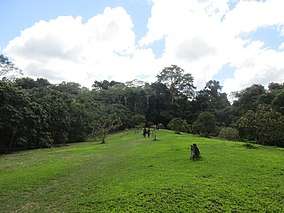Allpahuayo-Mishana National Reserve
The Allpahuayo-Mishana National Reserve (Spanish: Reserva Nacional Allpahuayo-Mishana) is a protected area in Peru located southwest of Iquitos in the Loreto Region, Maynas Province. The Nanay River flows through the northern part of the reserve.
| Allpahuayo-Mishana National Reserve | |
|---|---|
 | |
| Location | Loreto Region, Maynas Province, Peru |
| Coordinates | 3.928°S 73.556°W[1] |
| Area | 58,069.9 ha |
| Established | January 16, 2004 (D.S. 002-2004-AG) |
It was created in 1999 and covers an area of 142,272 acres. It is managed by SERNANP (Servicio Nacional de Áreas Naturales Protegidas por el Estado) which is a branch of the Ministry of Environment (Peru).
Biodiversity & Endemism
The Allpahuayo-Mishana National Reserve contains 500 varieties of trees per 2.5 acres, more than anywhere else on Earth, and nearly 100 unique plant species. There are over 1,900 flora species; 475 bird species; 143 species of reptiles; 71 species of amphibians; more than 90 species of parasitic wasps; and more butterfly species than any other site in the world.
More than 500 species of animals over 2.5 centimeters (1 inch) in length were found in a three-quarter hectare area of the Reserve - a world record.[2]
The rainforest in the Reserve is composed of several soil types - ranging from rare white quartz sands to red clays - and each of these soil types supports a unique community of plants and animals.
White sand forests are a rarely found ecosystem characterized by isolated patches of extremely poor soil; for this reason, many species adapted to this environment are extremely restricted in range. The ecosystem type, due to its isolated nature and distinctive environmental conditions, has been described as a "laboratory of evolution"[3]. There are 21 species of bird found within the Reserve that are associated only with the white sand forests, and since the inception of white-sands ornithological expeditions in the 1990s, novel and unique species are continually being discovered.[4] The white-sands forest protected by the reserve serves as critical habitat for the Ancient Antwren, Mishana Tyrannulet, Allpahuayo Antbird, and the Northern Chestnut-tailed Antbird; meanwhile, the critically endangered Iquitos Gnatcatcher is currently only known from within the boundaries of the reserve.
Three species of endangered primates are found within the reserve, and for two of them, the Yellow-handed Titi Monkey, and the Equatorial Saki Monkey, the Allpahuayo-Mishana National Reserve is the only place in Peru where these monkeys and their habitat have been officially protected.
Threats
Located only 23 km (14 miles) from Iquitos, around the Nanay River and its black-water tributaries, the Allpahuayo-Mishana National Reserve was previously only accessible by boat. However, with the construction of a new road between Iquitos and Nauta, it is now much more accessible putting it under a lot of pressure, from such practices as illegal invasion, hunting, agriculture and logging.
See also
- Natural and Cultural Peruvian Heritage
References
- "Allpahuayo Mishana". protectedplanet.net.
- "Allpahuayo Mishana National Reserve".
- Fine, Paul V. A.; Baraloto, Christopher (2016). "Habitat Endemism in White-sand Forests: Insights into the Mechanisms of Lineage Diversification and Community Assembly of the Neotropical Flora". Biotropica. 48: 24–33. doi:10.1111/btp.12301.
- https://bioone.org/journals/The-Wilson-Journal-of-Ornithology/volume-113/issue-1/0043-5643(2001)113[0001:ANZTAT]2.0.CO;2/A-NEW-iZIMMERIUS-i-TYRANNULET-AVES--TYRANNIDAE-FROM-WHITE/10.1676/0043-5643(2001)113[0001:ANZTAT]2.0.CO;2.full
External links
- www.inrena.gob.pe / Allpahuayo-Mishana National Reserve (Spanish)
- www.sernanp.gob.pe / Allpahuay-Mishana (Spanish)
- PeruNorth /Allpahuayo-Mishana National Reserve - World-Record Biodiversity
Iquitos Times / Allpahuayo-Mishana